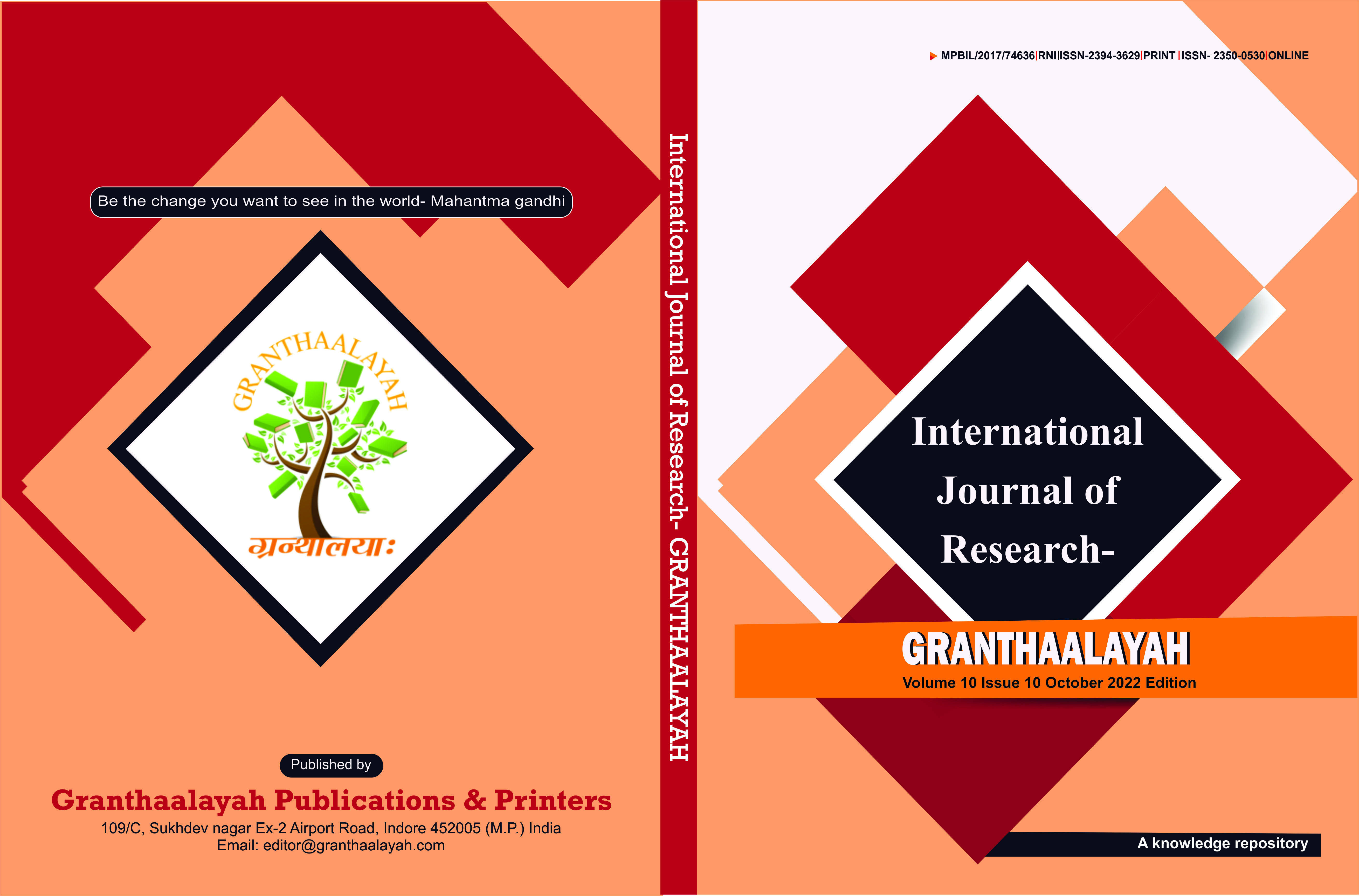ULTRASOUND-ASSISTED ADSORPTION HG (II) USING KAOLIN ADSORBENTS MODIFIED WITH ANIONIC SURFACTANT
DOI:
https://doi.org/10.29121/granthaalayah.v10.i10.2022.4829Keywords:
Kaolinite, Adsroben, Ultrasonic Assisted, Metal Hg, TDSAbstract [English]
This study aims to test the reservoir wastewater containing domestic waste using a modified kaolinite adsorbent with Alkyl Benzene Sulfonate surfactant using ultrasonic technology (KM). First, the adsorbent to be used is characterized using several different techniques such as SEM analysis, and FTIR and the calculation of the efficiency of the adsorbent concerning contact time with wastewater. Meanwhile, the wastewater tested was tested for the effect of contact time on TDS and PH. The results of the analysis show that the maximum waste reduction efficiency occurs in modified kaolin (KM), where adsorption occurs faster than in unmodified natural kaolin (PK). The maximum percentage is 84, 21% for metal removal efficiency using modified kaolin at a contact time of 45 minutes and a weight of 1.8 g of adsorbent, while kaolin without modification has an efficiency of 62.47% at a contact time of 80 minutes and a weight of 1.8 g of adsorbent. The contact time test on the TDS value of wastewater that has been adsorbed with KM shows that the TDS value is getting lower over time, which indicates the Hg (II) ion has been dispersed and fused so that the Hg (II) metal in the water is reduced. The use of the adsorption method with the help of ultrasonic technology is proven to be more efficient in accelerating the removal of Hg (II) ions by increasing the surface dispersion of the adsorbent with metal ions in water. The contact time test on the TDS value of wastewater that has been adsorbed with KM shows that the TDS value is getting lower over time, which indicates the Hg (II) ion has been dispersed and fused so that the Hg (II) metal in the water is reduced. The use of the adsorption method with the help of ultrasonic technology is proven to be more efficient in accelerating the removal of Hg (II) ions by increasing the surface dispersion of the adsorbent with metal ions in water. The contact time test on the TDS value of wastewater that has been adsorbed with KM shows that the TDS value is getting lower over time, which indicates the Hg (II) ion has been dispersed and fused so that the Hg (II) metal in the water is reduced. The use of the adsorption method with the help of ultrasonic technology is proven to be more efficient in accelerating the removal of Hg (II) ions by increasing the surface dispersion of the adsorbent with metal ions in water.
Downloads
References
Adhinugroho, P. (2018). Test the Effectiveness of Microorganisms (DDL-LActobacillus) on the Wastewater Treatment Process from Setiabudi Reservoir-PD PAL Jaya. THESIS-2000.
Anais, A., Maria, R., and Sun-Kou (2021). Comparative Study of Anion Removal Using Adsorbent Made from Homoiconic Clay. Environmental Nanotechnology, Monitoring and Management. 15. https://doi.org/10.1016/j.enmm.2021.100476. DOI: https://doi.org/10.1016/j.enmm.2021.100476
Anirudhan, T.S., and Ramachandran, M. (2015). Removal of Basic Dye Adsorption from Aqueous Solution by Surfactant Modified Bentonite Clay (organoclay): Kinetic and Competitive Adsorption Isotherm. Process Safety and Environmental Protection, 95, 215-225. https://doi.org/10.1016/j.psep.2015.03.003. DOI: https://doi.org/10.1016/j.psep.2015.03.003
Ayisha Sidiqua, M., and Priya, V.S. (2021). Removal of Yellow Dye Using a Composite Bound Adsorbent Developed Using Natural Clay and Activated Carbon from Sapindus Seeds. Biocatalysis and Agricultural Biotechnology, 33. https://doi.org/10.1016/j.bcab.2021.101965. DOI: https://doi.org/10.1016/j.bcab.2021.101965
Azha, S. F., Shahadat, M., Ismail, S., Ali, S. W., Ahammad, S. Z. (2021). Prospects of Clay-Based Flexible Adsorbent Coatings as a Cleaner Production Technique Inwastewater Treatment, Challenges, and Issues : Overview. Journal of the Taiwan Institute of Chemical Engineers. 120, 178-206. https://doi.org/10.1016/j.jtice.2021.03.018. DOI: https://doi.org/10.1016/j.jtice.2021.03.018
Coelho, G.F., Goncalves JR, A.C., Tarley, C.R.T., Casarin, J., Nacke, H., and Francziskowski, M.A. (2014). Removal of Metal Ions Cd (II), Pb (II), and Cr (III) from Water by Skin Anacardium Occidental Cashew Nuts. Ecological Engineering. 73, 514 - 525. https://doi.org/10.1016/j.ecoleng.2014.09.103. DOI: https://doi.org/10.1016/j.ecoleng.2014.09.103
Emam, A.A., LFM Ismail, Abdel Khalek, M.A., and Rehan, A. (2017). Study of Adsorption of Several Heavy Metal Ions in Modified Kaolinite Clay. International Journal of Advances in Engineering Technology, 3, 152-163.
Estrada, J. M., and Bhamidimarri, R. (2016). A Review of the Issues and Treatment Options for Wastewater from Shale Gas Extraction by Hydraulic Fracturing. Fuel, 182, 292-303. https://doi.org/10.1016/j.fuel.2016.05.051. DOI: https://doi.org/10.1016/j.fuel.2016.05.051
Fainerman, V.B., Aksenenko, E.V., Kovalchuk, V.I., Mucic, N., Javadi, A., Liggieri, L., Schneck, E. (2020). A New View on Surfactant Adsorption at the Water/Alkane Interface - Competitive and Cooperative Effects of Surfactants and Molecules Alkane. Advances in Colloidal and Interface Science. 279. https://doi.org/10.1016/j.cis.2020.102143. DOI: https://doi.org/10.1016/j.cis.2020.102143
Gupta, V.K., Tyagi, I., Agarwal, S., Moradi, O., Sadegh, H., Shahryari-Ghoshekandi, R., Makhlouf, ASH, Goodarzi, M., and Garshasbi, A. (2016). Studies on Heavy Metal Ion Removal of Industrial Waste by Carbon Nanotubes : Effects of Surface Modification - A Review. Critical Reviews in Environmental Science and Technology. 46, 93- 118. https://doi.org/10.1080/10643389.2015.1061874. DOI: https://doi.org/10.1080/10643389.2015.1061874
Haroon, H., Ashfaq, T., Gardazi, S.M.H., Sherazi, T.A. Ali, M., Rasyid, N., Bilal, M. (2016). Kinetic and Thermodynamic Study of Cr (VI) Adsorption Equilibrium on New Adsorbent of Eucalyptus Camaldulensis Waste: Batch Reactor and Column. Korean Journal of Chemical Engineering, 33, 2898-2907. https://doi.org/10.1007/s11814-016-0160-0. DOI: https://doi.org/10.1007/s11814-016-0160-0
Huan, Z., Qingdong, H., Wenting, Z., Fang, G., Lei, H., Wenbo, W. (2021). Superior Dye Removal with Recyclable Magnetic Silicate Fe3o4 Adsorbent Synthesized from Abundant Natural Mixed Clay. Chemical Engineering Research and Design. 175, 272-282. https://doi.org/10.1016/j.cherd.2021.09.017. DOI: https://doi.org/10.1016/j.cherd.2021.09.017
Jeeva, M., Lakkaboyana, S.K., and WY, W.Z. (2019). Adsorption of Direct Brown 1 Dye Using Surfactant- Modified Kaolinite and Kaolinite. Malaysian Geological Society Bulletin, 67, 35-45. https://doi.org/10.7186/bgsm67201905. DOI: https://doi.org/10.7186/bgsm67201905
Leal, P.V., Magriotis, Z.M., Sales, P.F., Papini, R.M., Viana, P.R. (2017). Effect of Kaolinic Acid Treatment Conditions on Ether Amine Adsorption : Comparative Analysis Using a Chamomile Tonic Tool. Journal of Environmental Management. 197, 393-403. https://doi.org/10.1016/j.jenvman.2017.04.003. DOI: https://doi.org/10.1016/j.jenvman.2017.04.003
Mahmoodi, N. M. (2014). Synthesis of Core-Shell Magnetic Adsorbent Nanoparticles and Selectivity Analysis for Binary System Dye Removal. Journal of Industrial and Engineering Chemistry, 20(4), 2050-2058. https://doi.org/10.1016/j.jiec.2013.09.030. DOI: https://doi.org/10.1016/j.jiec.2013.09.030
Mahmoodi, N.M., Oveisi, M., Taghizadeh, A., Taghizadeh, M. (2019). New Magnetic Amine-Activated Organic Carbon Nanotubes/Metal Nanocomposites: from Green Ultrasound-Assisted Synthesis to Detailed Selective Pollutant Removal Models of Binary Systems. Journal of Hazardous Materials. 368, 746-. 759. https://doi.org/10.1016/j.jhazmat.2019.01.107. DOI: https://doi.org/10.1016/j.jhazmat.2019.01.107
Mishra, S. P. (2014). Adsorption–desorption of heavy metal ions. Current Science, 107(4), 601–612.
Mouni, L., Belkhiri, L., Bollinger, J.C., Bouzaza, A., Assadi, A., Tirri, A., Remini, H. (2018). Removal of Methylene Blue From Aqueous Solution by Adsorption on Kaolin : Kinetic and Equilibrium Studies. Applied Clay Science. 153, 38-45. https://doi.org/10.1016/j.clay.2017.11.034. DOI: https://doi.org/10.1016/j.clay.2017.11.034
Mudzielwana, R., Gitari, M.W., and Ndungu, P. (2019). Performance Evaluation of Surfactant-Modified Kaolin Clay in the Adsorption of As (III) and As(V) from Groundwater: Adsorption Kinetics, Isotherms, and Thermodynamics. Heliyon, 5, 1-7. https://doi.org/10.1016/j.heliyon.2019.e02756. DOI: https://doi.org/10.1016/j.heliyon.2019.e02756
Mustapha, S., Ndamitso, M.M., Abdulkareem, A.S., Tijani, J.O., Mohammed, A.K., and Shuaib, D.T. (2019). Potential Use of Kaolin as a Natural Adsorbent to Remove Pollutants from Tannery Wastewater. Heliyon, 5, 1-9. https://doi.org/10.1016/j.heliyon.2019.e02923. DOI: https://doi.org/10.1016/j.heliyon.2019.e02923
Nugraha, I., and Kulsum, U. (2017). Synthesis and Characterization of Kaolin-ZVI (Zero Valent Iron) Composite Materials and their Application Tests as Cr (VI) Cation Adsorbents. Journal of VALENCY Chemistry, 3(1), 59-70. https://doi.org/10.15408/jkv.v3i1.4650 DOI: https://doi.org/10.15408/jkv.v3i1.4650
Ogbu, I., Akpomie, K., Osunkunle, A., and Eze, S. (2019). Sawdust-kaolinite composite as efficient sorbent for heavy metal ions. Bangladesh Journal of Scientific and Industrial Research, 54(1), 99–110. https://doi.org/10.3329/bjsir.v54i1.40736 DOI: https://doi.org/10.3329/bjsir.v54i1.40736
Pakaya, K. (2020). Test Effectiveness Of Alu (Aluminum Sulfate) To Reduce Tds, Tss, And Ph Levels In Laundry Business Liquid Wastewater In Sub-District Central City, Gorontalo.Thesis,1(811415005).
Putri, H. D., Elfidasari, D., Haninah, H., and Sugoro, I. (2022). Bahaya Kandungan Logam Berat (Cd, Hg, Pb) Pada Produk Olahan Pterigoplichthys Pardalis Asal Sungai Ciliwung Jakarta Bagi Kesehatan Manusia. Jurnal Pengolahan Pangan, 7(1), 7-13. https://doi.org/10.31970/pangan.v7i1.61. DOI: https://doi.org/10.31970/pangan.v7i1.61
Rao, R.A.K., Ikram, S., Uddin, M.K. (2014). Removal of Cd (II) from Aqueous Solution by Exploring the Biosorption Characteristics of Gaozaban (Onosma Bracteatum). Journal of Environmental Chemical Engineering, 2(2), 1155-1164. https://doi.org/10.1016/j.jece.2014.04.008. DOI: https://doi.org/10.1016/j.jece.2014.04.008
Raya, S.I., and Zakir, M. (2014). Adsorption of Pb (II) Ions on Activated Carbon from Rice Husk, Exposed to Ultrasonic Waves : Kinetic and Thermodynamic Studies. Journal of Natural Science Research. 4(2), 4-9.
Ridwan, Wirjosentono, B., Tamrin, Siburian, R., Rihayat, T., and Nurhanifa (2018). Modification of PLA/PCL/Aceh's Bentonite Nanocomposites as Biomedical Materials. AIP Conference Proceedings, 2049(1), 02008. https://doi.org/10.1063/1.5082413. DOI: https://doi.org/10.1063/1.5082413
Rihayat, T., and Suryani (2010). Synthesis and Properties of Biobased Polyurethane/Montmorillonite Nanocomposites. International Journal of Materials and Metallurgical Engineering, 4(5).
Rihayat, T., Hadi, A. E., Aidy, N., Safitri, A., Siregar, J. P., Cionita, T., Irawan, A. P., et al. (2021). Biodegradation of Polylactic Acid-Based Bio Composites Reinforced with Chitosan and Essential Oils as Anti-Microbial Material for Food Packaging. Polymers, 13(22), 4019. MDPI AG. http://dx.doi.org/10.3390/polym13224019. DOI: https://doi.org/10.3390/polym13224019
Rihayat, T., Suryani, Satriananda, Ridwan, Nurhanifa, Putra, A., Audina, N., Yunus, M., Sariadi, Safari, Jalal, R., Khan, N. S. P., and Saifuddin (2018). Influence of Coating Polyurethane With Mixture of Bentonite and Chitosan Nanocomposites. AIP Conference Proceedings, 2049(1), 020020. https://doi.org/10.1063/1.5082425. DOI: https://doi.org/10.1063/1.5082425
Rihayat, T., Suryani, Zaimahwati, Salmyah, Sariadi, Fitria, Satriananda, Putra, A., Fona, Z., Juanda, Raudah, Safitri, A., Mawaddah, Nurhanifa, Riskina, S., and Syahputra, W., (2019). Composition of Extraction of Lemongrass Fragrant Essential Oil by Microwave Water Hydro Distillation Method on Dermatitis Perfume Production. https://doi.org/10.1088/1757-899X/506/1/012053 DOI: https://doi.org/10.1088/1757-899X/506/1/012053
Roosta, M., Ghaedi, M., Shokri, N., Daneshfar, A., Sahraei, R., Asghari, A. (2017). Optimization of the Ultrasonic/Adsorption Combined Method for the Removal of Malachite Green by Gold Nanoparticles Loaded on Activated Carbon : Experimental Design. Spectrochimica Acta Part A: Molecular and Biomolecular Spectroscopy. 118, 55-65. https://doi.org/10.1016/j.saa.2013.08.082. DOI: https://doi.org/10.1016/j.saa.2013.08.082
Safitri, N., Syahputra, R., Putri, K., Rihayat, T., Nurhanifa, A. (2020). Purifying Citronella Oil (Cymbopogon Nardus L) by Utilizing Sunlight Using Solar Cells (Photovoltaics). IOP Conference Series: Material Science and Engineering, 854, 012051. https://doi.org/10.1088/1757-899X/854/1/012051. DOI: https://doi.org/10.1088/1757-899X/854/1/012051
Saleh, A.T., Sari, A., and Tuzen, M. (2016). Chitosan-Modified Vermiculite for As(III) Adsorption from Aqueous Solution: Equilibrium, Thermodynamic and Kinetic Studies.Journal of Molecular Liquids. 219, 937-945. https://doi.org/10.1016/j.molliq.2016.03.060. DOI: https://doi.org/10.1016/j.molliq.2016.03.060
Santhosh, C., Velmurugan, V., Jacob, G., Jeong, S.K., Grace, A.N., Bhatnagar, A. (2016). The Role of Nanomaterials in Water Treatment Applications : A Review. Chemical Engineering Journal. 306, 1116 -1137. https://doi.org/10.1016/j.cej.2016.08.053. DOI: https://doi.org/10.1016/j.cej.2016.08.053
Singh, N., and Gupta, S.K. (2016). Heavy Metal Adsorption : A Review. International Journal of Innovative Research in Science, Engineering and Technology, 5(2), 2267 -2281.
Siyal, A. A., Shamsuddin, M. R., Khan, M. I., Rabat, N. E., Zulfiqar, M., Man, Z., Siame, J., Azizlia, A. K. (2018). A Review on Geopolymers as Emerging Materials for the Adsorption of Heavy Metals and Dyes. Journal of Environmental Management, 224, 327-339. https://doi.org/10.1016/j.jenvman.2018.07.046. DOI: https://doi.org/10.1016/j.jenvman.2018.07.046
Sodeifian, G., and Ali, S. (2018). Utilization of Ultrasonic-Assisted Resolv (US-RESOLV) with Polymer Stabilizers for the Production of Amiodarone Hydrochloride Nanoparticles: Process Optimization. Chemical Engineering Research and Design. 142, 268-284. https://doi.org/10.1016/j.cherd.2018.12.020. DOI: https://doi.org/10.1016/j.cherd.2018.12.020
Soltani, R. D. C., Jordi, S., Safari, M., and Rajaei, M.-S. (2016). Sonocatalysis Enhancement of Textile Wastewater Using Bentonite-Supported ZnO Nanoparticles: A Response Surface Methodology Approach. Journal of Environmental Management. 179, 47-57. https://doi.org/10.1016/j.jenvman.2016.05.001. DOI: https://doi.org/10.1016/j.jenvman.2016.05.001
Sun, K., Shi, Y., Chen, H., Wang, X., and Li, Z. (2015). Extending Surfactant-Modified 2:1 Clay Minerals for Absorption and Removal of Diclofenac from Water. Journal of Hazardous Materials, 323, 567-574. https://doi.org/10.1016/j.jhazmat.2016.05.038. DOI: https://doi.org/10.1016/j.jhazmat.2016.05.038
Suryani, Agusnar, H., Wirjosentono, B., Rihayat, T., Nurhanifa (2018). Thermal Degradation of Aceh's Bentonite Reinforced Poly Lactic Acid (PLA) Based on Renewable Resources for Packaging Application. AIP Conference Proceedings 2049, 020040. https://doi.org/10.1063/1.5082445.
Suryani, Agusnar, H., Wirjosentono, B., Rihayat, T., Nurhanifa (2018). Thermal Degradation of Acehnese Reinforced Poly Lactic Acid (PLA) Bentonite Based on Renewable Resources for Packaging Applications. AIP Conference Proceedings, 2049, 1-5. https://doi.org/10.1063/1.5082445. DOI: https://doi.org/10.1063/1.5082445
Suryani, Fitria, Rihayat, Teuku, Aidy, Nurhanifa, Hasnah, T, Y. R. (2020). Chitosan Modified Bio-Fibre Based Board as Antimicrobial and Anti-Crack Board. IOP Conference Series: Material Science and Engineering, 854. https://doi.org/10.1088/1757-899X/854/1/012050. DOI: https://doi.org/10.1088/1757-899X/854/1/012050
Udin, M. K. (2017). Overview of Heavy Metal Adsorption by Clay Minerals, with Special Focus on the Last Decade. Journal of Chemical Engineering, 308, 438-62. https://doi.org/10.1016/j.cej.2016.09.029. DOI: https://doi.org/10.1016/j.cej.2016.09.029
Vargas, A., Cazetta, M., Kumita, T. Silva, V. Almeida (2011). Adsorption of Methylene Blue on Activated Carbon Produced from Flamboyant Pods {(D}elonix Regia) : A Study of Adsorption Isotherms and Kinetic Models. Chemical Engineering Journal. 168(2), 722-730. https://doi.org/10.1016/j.cej.2011.01.067. DOI: https://doi.org/10.1016/j.cej.2011.01.067
Wu, Q., You, R., Lv, Q., Xu, Y., You, W., Yu, Y. (2015). Efficient Simultaneous Removal of Cu (II) and Cr2O72− from Aqueous Solution by Renewable Amphoteric Functional Mesoporous Silica. Chemical Engineering Journal. 281, 491-501. https://doi.org/10.1016/j.cej.2015.07.019. DOI: https://doi.org/10.1016/j.cej.2015.07.019
Published
How to Cite
Issue
Section
License
Copyright (c) 2022 Alfian Putra, Zaimahwati, Rizal Syahyadi, Teuku Rihayat, Rima Dhinta Dewi Astuti, Isra Adelya Izzati

This work is licensed under a Creative Commons Attribution 4.0 International License.
With the licence CC-BY, authors retain the copyright, allowing anyone to download, reuse, re-print, modify, distribute, and/or copy their contribution. The work must be properly attributed to its author.
It is not necessary to ask for further permission from the author or journal board.
This journal provides immediate open access to its content on the principle that making research freely available to the public supports a greater global exchange of knowledge.

























